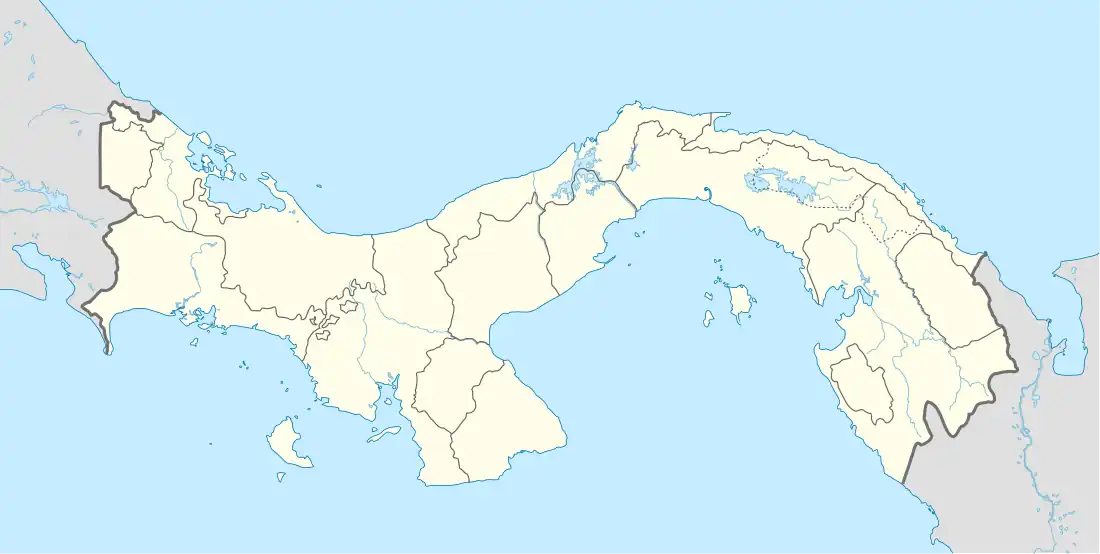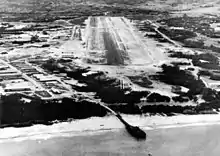Battle of Rio Hato Airfield
The Battle of Rio Hato Airfield took place as an opening action of the United States invasion of Panama, and was fought between the U.S military and the Panama Defense Forces (PDF) on 20 December 1989. The action saw US paratroopers launch a surprise attack against the PDF at Rio Hato, the largest PDF military base in the country, approximately seventy miles south of Panama City.
| Battle of Rio Hato Airfield | |||||||
|---|---|---|---|---|---|---|---|
| Part of the United States invasion of Panama | |||||||
 Rio Hato Battle of Rio Hato Airfield (Panama) | |||||||
| |||||||
| Belligerents | |||||||
|
|
| ||||||
| Commanders and leaders | |||||||
|
|
| ||||||
| Units involved | |||||||
| |||||||
| Strength | |||||||
|
837 rangers 13 C-130 transport planes 2 AC-130H gunships 2 F-117 bombers 2 AH-64 helicopters 2 MH-6 helicopters |
520 soldiers 150 automatic rifles 42 machine guns 9 bazookas 4 recoilless rifles 23 mortars 19 armoured vehicles 6 ZPU AA guns | ||||||
| Casualties and losses | |||||||
|
4 killed 44 wounded |
34 killed 362 captured 200+ escaped | ||||||
| Low civilian casualties | |||||||
The objective of the attack was to capture the PDF garrison at the base, secure the airfield runway, and seize dictator Manuel Noriega's beachside house.[1]
The Battle

At H-hour two F-117A stealth fighter-bombers delivered two 2,000-lb. precision bombs in an attempt to stun and confuse the PDF garrison of two heavily armed infantry companies defending the airfield. Instead of landing at their targets both bombs set off nearby waking the garrison. The PDF 6th and 7th Rifle companies numbered a total of 520 troops, of which the 7th company was known to be a "part of Noriega's best trained and most loyal forces".[2]
Thirteen C-130 Hercules transport aircraft, having flown nonstop from the United States with troops from the 75th Ranger Regiment, parachuted in the entire 2nd Ranger Battalion (2/75) and one company from the 3rd Ranger Battalion (3/75), with the remainder of 3/75 going to Howard Air Force Base in reserve as a reactionary force. The jump was conducted from a dangerously low altitude of 490 feet (149 m), as intelligence had stated that the PDF anti-aircraft weaponry could not track accurately below 500 feet (152 m). Regardless, 11 of the 13 aircraft were hit by 23mm anti-aircraft (AA) fire. The combination of a faster than normal air speed of 170 knots (315 km/h; 196 mph) and the low altitude contributed to the several dozen that were injured while landing. Multiple Rangers were also wounded by ground fire coming through the aircraft, with several more wounded while under canopy also from ground fire. At least one Ranger was killed and one paralyzed when their static lines were cut from AA fire. Gathering quickly in the darkness, two companies of Rangers fanned out to isolate the airfield, cut the Pan-American Highway running through it, and seize a nearby ammunition dump.[3]
At least two military trucks filled with PDF soldiers drove down the runway and adjacent dirt road, raking the wounded and the assembling Rangers with small arms and .50 BMG fire. These were dispatched by a Ranger platoon sergeant from 3/75 with a M72 LAW rocket; a noncommissioned officer from A Company, 2/75, fired on a truck with his M1911 pistol and inadvertently hit the gas tank, exploding said vehicle.
At least one PDF APC engaged Rangers on the west end of the airfield. It was dispatched with simultaneous fire from Rangers firing LAW rockets and from a AC-130H Spectre gunship.
However, in one case of mistaken identity, a US attack helicopter mistook a squad of Rangers for a group of PDF and fired, killing two and wounding four others.
Meanwhile, a Ranger company attacked a nearby NCO academy complex and yet another struck the two PDF companies deployed to defend the airfield. The fighting turned into a ferocious exchange of fire, with the ground fire of the Rangers heavily reinforced by support from an AC-130 Spectre and several attack helicopters.
The contested buildings fell in room-to-room fighting, including grenades and automatic rifles at close ranges. The Battle of Rio Hato Airfield lasted roughly five hours, by which time the Rangers had secured Rio Hato, as well as Manuel Noriega’s lavish beach house nearby.
Casualties
The U.S military lost 4 killed, 18 wounded, and 26 injured in the jump.[2][4] At Rio Hato, the PDF lost 34 soldiers killed, 362 captured, and a huge inventory of weapons abandoned. Around 200 PDF soldiers managed to flee into the countryside and evade capture.[5]
References
- The Praetorian STARShip : the untold story of the Combat Talon. DIANE Publishing. 2001. ISBN 9781428990432.
- "Patriotman.com: The Panama Invasion". www.patriotman.com. Archived from the original on 4 March 2016. Retrieved 31 December 2015.
- Pedraja, René De La (20 September 2013). Wars of Latin America, 1982-2013: The Path to Peace. McFarland. ISBN 9780786470167.
- "The Seizure of Rio Hato Airfield (1989) - ShadowSpear Special Operations". ShadowSpear Special Operations. shadowspear.com. Archived from the original on 23 January 2016. Retrieved 31 December 2015.
- Cole, Ronald H. (November 1995). "OPERATION JUST CAUSE The Planning and Execution of Joint Operations in Panama February 1988 – January 1990" (PDF). Joint Chiefs of Staff. Retrieved 18 February 2023.